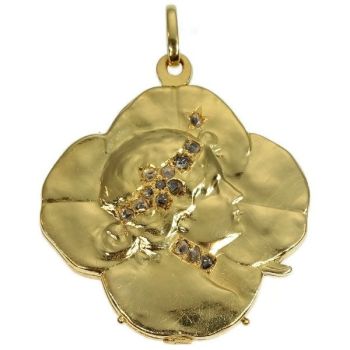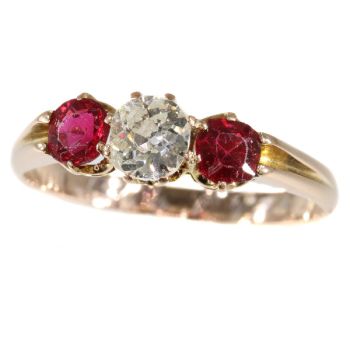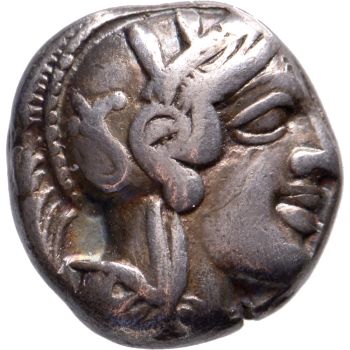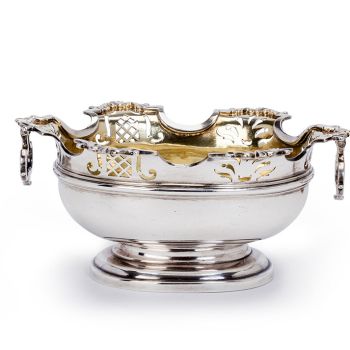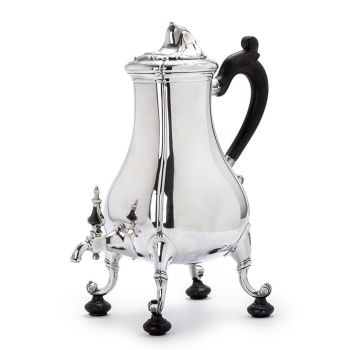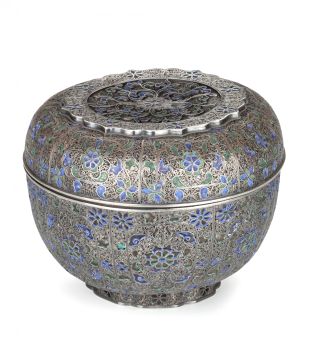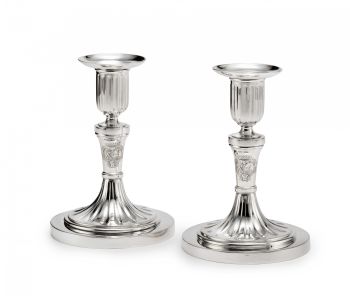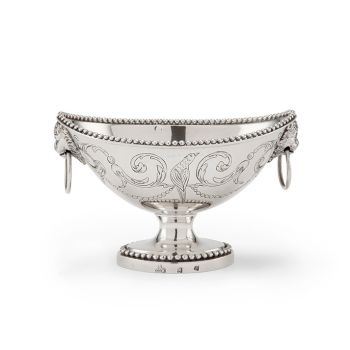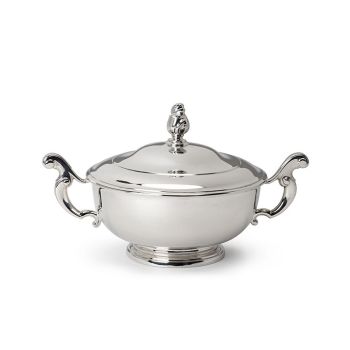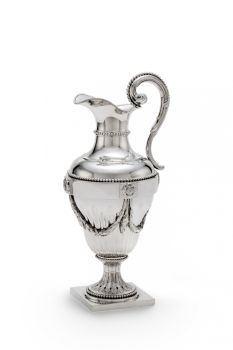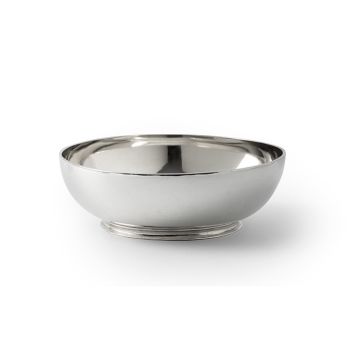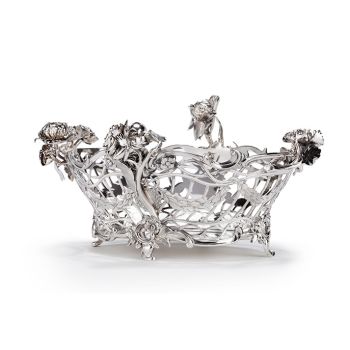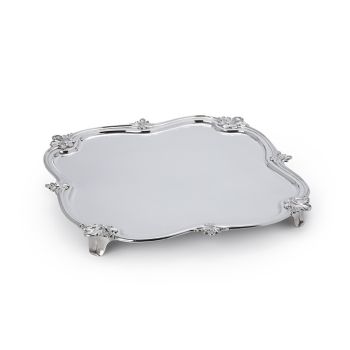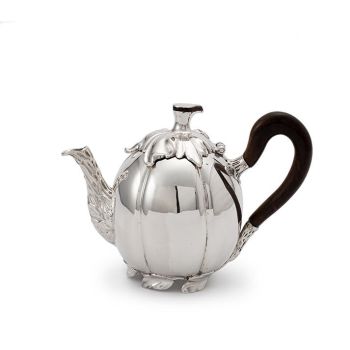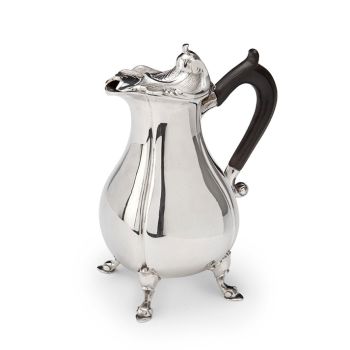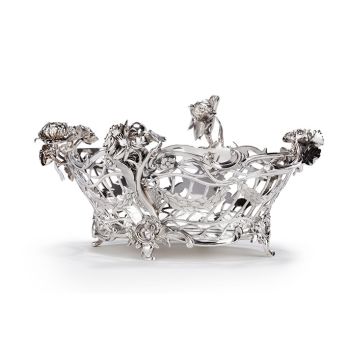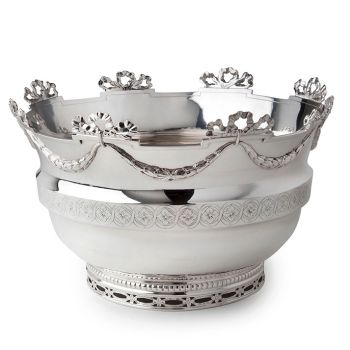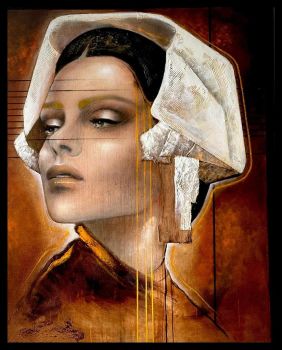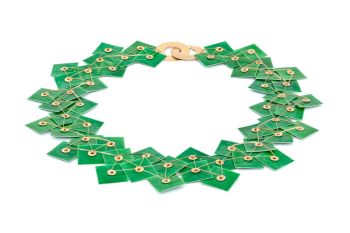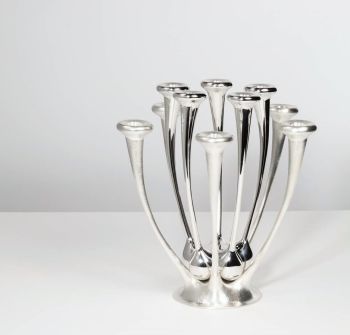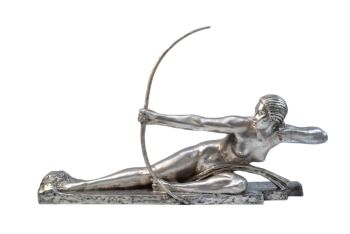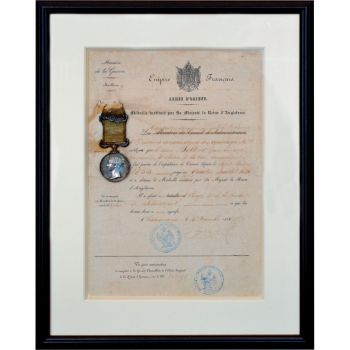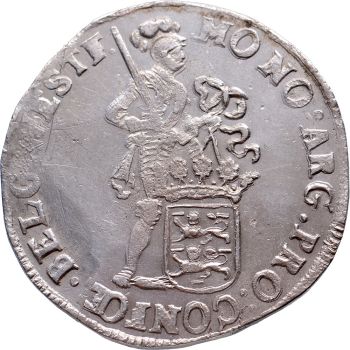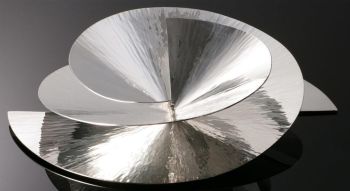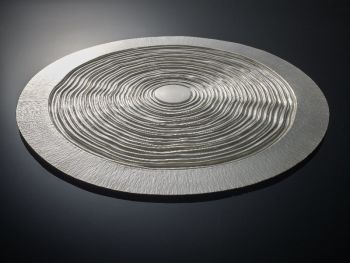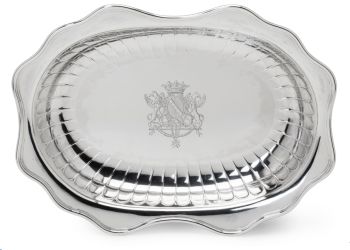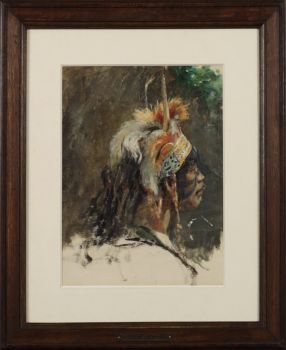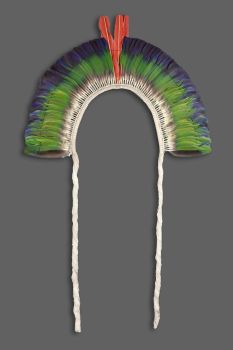A magnificent Portuguese-colonial Brazilian silver ewer and basin 1780
Artiste Inconnu
Argent
30 ⨯ 53 ⨯ 4 cm
Prix sur demande
Zebregs & Röell - Fine Art - Antiques
- Sur l'oeuvre d'artRio de Janeiro, circa 1780, with an unidentified maker’s mark HSC, and town mark R for Rio de Janeiro
L. 53 x W. 39 x H. 4 cm / Weight: 2480 grams (basin)
H. 30 x W. 12 cm / Weight: 2040 grams (ewer)
The quality of this ewer and basin, both in form and in
chiselling and engraving truly is exceptional. They probably are by the same maker as a very similar ewer in the Catedral São Sebastião do Rio de Janeiro, and an ewer and basin, in the Mosteiro de São Bento, a monastery in Rio - both unmarked and dated second half 18th century. The most obvious difference is the handle which in these two ewers is in the form of a dragon instead of a woman. Brazilian silver, even very large pieces, mainly when ordered by the church, is very seldomly marked, and so far, no research into Brazilian silver marks has been conducted. The use of these hand-washing basins and ewers at the table was a welcome requirement due to the frequent absence of cutlery.
Literature:
- Humberto M. Franceshi, O Ofício da Prata no Brasil, Rio de Janeiro, 1988, p. 182-185
- Manuel Gonçalves Vidal, Marcas de Contrastes e Ourives Portugueses, Lisbon, 1974 - Sur l'artiste
Il peut arriver qu'un artiste ou un créateur soit inconnu.
Certaines œuvres ne doivent pas être déterminées par qui elles sont faites ou elles sont faites par (un groupe d') artisans. Les exemples sont des statues de l'Antiquité, des meubles, des miroirs ou des signatures qui ne sont pas claires ou lisibles, mais aussi certaines œuvres ne sont pas signées du tout.
Vous pouvez également trouver la description suivante :
•"Attribué à …." A leur avis probablement une oeuvre de l'artiste, au moins en partie
•« Atelier de …. ou « Atelier de » À leur avis, une œuvre exécutée dans l'atelier ou l'atelier de l'artiste, éventuellement sous sa direction
•« Cercle de… ». A leur avis une oeuvre de la période de l'artiste témoignant de son influence, étroitement associée à l'artiste mais pas forcément son élève
•« Style de … ». ou "Suiveur de ...." Selon eux, une œuvre exécutée dans le style de l'artiste mais pas nécessairement par un élève ; peut être contemporain ou presque contemporain
•« Manière de… ». A leur avis une oeuvre dans le style de l'artiste mais d'une date plus tardive
•"Après …." A leur avis une copie (quelle qu'en soit la date) d'une oeuvre de l'artiste
•« Signé… », « Daté… ». ou « Inscrit » À leur avis, l'œuvre a été signée/datée/inscrite par l'artiste. L'ajout d'un point d'interrogation indique un élément de doute
• "Avec signature ….", "Avec date ….", "Avec inscription …." ou "Porte signature/date/inscription" à leur avis la signature/date/inscription a été ajoutée par quelqu'un d'autre que l'artiste
Êtes-vous intéressé par l'achat de cette oeuvre?
Artwork details
Related artworks
- 1 - 4 / 12
Artiste Inconnu
A silver spoon commemorating Juff’ Margareta van Hoorn1656 - 1694
Prix sur demandeZebregs & Röell - Fine Art - Antiques
Artiste Inconnu
UN PLAT EN ARGENT LOBBED INDONÉSIEN INSOLITElate 17th
Prix sur demandeZebregs & Röell - Fine Art - Antiques
Paulus Franciscus Kromjong
Fleurs devant Arearea Aka (joie) par Gauguin '20th century
Prix sur demandeZebregs & Röell - Fine Art - Antiques
Artiste Inconnu
Japanese transition-style lacquer coffer 1640 - 1650
Prix sur demandeZebregs & Röell - Fine Art - Antiques
Artiste Inconnu
A Surinam-themed Amsterdam long-case clock1746 - 1756
Prix sur demandeZebregs & Röell - Fine Art - Antiques
 Sélectionné par
Sélectionné parGallerease Magazine
1 - 4 / 20Elisabeth Treskow
Lapis lazuli afghan incrusté d'or sur un support en argent1950 - 1960
Prix sur demandeJacob J. Roosjen SRI
1 - 4 / 24Artiste Inconnu
A Surinam-themed Amsterdam long-case clock1746 - 1756
Prix sur demandeZebregs & Röell - Fine Art - Antiques
 Sélectionné par
Sélectionné parGallerease Magazine
Artiste Inconnu
UN FILET D'IVOIRE D'UN DUTCHMAN TENANT UN COCKEREL18th century
Prix sur demandeZebregs & Röell - Fine Art - Antiques
Artiste Inconnu
A silver spoon commemorating Juff’ Margareta van Hoorn1656 - 1694
Prix sur demandeZebregs & Röell - Fine Art - Antiques
Artiste Inconnu
UNE COLLECTION DE QUATRE BOÎTES À BIBLE EN IVOIRE SRI LANKAN18th century
Prix sur demandeZebregs & Röell - Fine Art - Antiques
Artiste Inconnu
UN PLAT EN ARGENT LOBBED INDONÉSIEN INSOLITElate 17th
Prix sur demandeZebregs & Röell - Fine Art - Antiques
1 - 4 / 24- 1 - 4 / 24
Engelbert Kaempfer
LIVRE ENGELBERT KAEMPFER1651 - 1716
Prix sur demandeZebregs & Röell - Fine Art - Antiques
Artiste Inconnu
GRANDE PEINTURE INDIENNE IMPORTANTE ET RARE `` STYLE D'ENTREPRISE '' SUR IVOIRE REPRÉSENTANT UN DÉFI1850 - 1900
Prix sur demandeZebregs & Röell - Fine Art - Antiques
 Sélectionné par
Sélectionné parDanny Bree
Artiste Inconnu
UNE TÊTE DE PLUME TRIBU JURUNA1900 - 1950
Prix sur demandeZebregs & Röell - Fine Art - Antiques
Artiste Inconnu
A silver spoon commemorating Juff’ Margareta van Hoorn1656 - 1694
Prix sur demandeZebregs & Röell - Fine Art - Antiques
Artiste Inconnu
A Surinam-themed Amsterdam long-case clock1746 - 1756
Prix sur demandeZebregs & Röell - Fine Art - Antiques
 Sélectionné par
Sélectionné parGallerease Magazine
1 - 4 / 12








